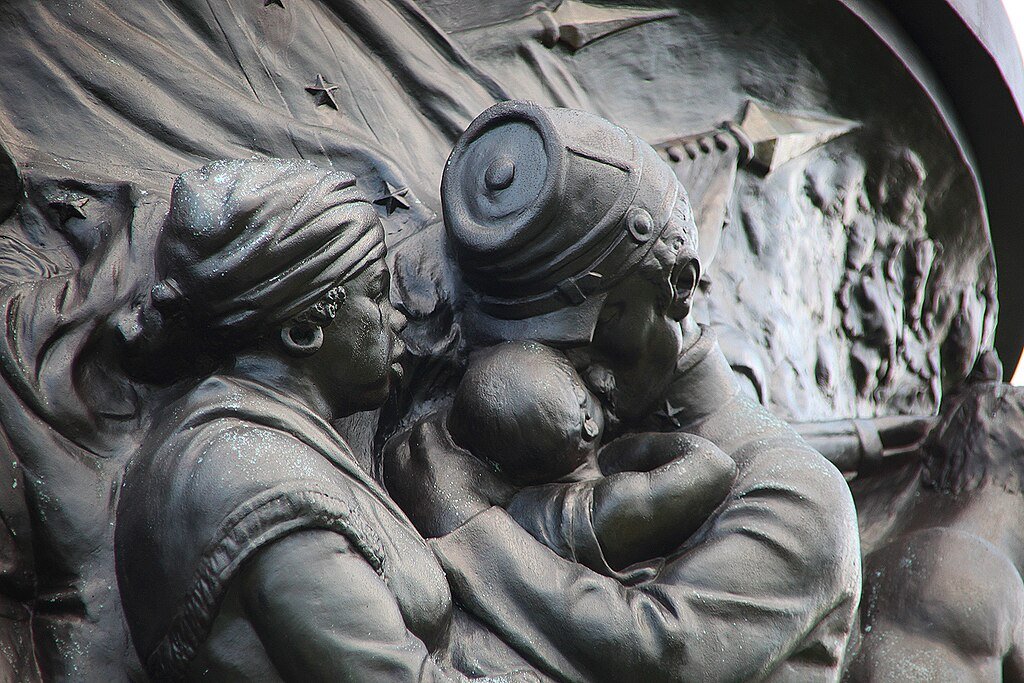Confederate Monuments in Cemeteries, Reminders That We Cannot All Rest In Peace
Sandra Baker | May 3, 2021
I will never forget the moment our hearse drove through the confederate section at a local cemetery. Roughly a dozen family cars trailed behind and my heart sunk as we passed by each one of them. As we came to our tent, a statue of General Robert E. Lee was only a few yards away. While easing the casket out of the back of the hearse, Lee stared, valiantly posed atop a rearing horse, as if ready for battle. I wondered how many other African American burials General Lee had been a part – during his life as a slave holder, and in death as a recurring figure in American cemeteries. Lee commanded the Confederate army and died defending the enslavement of Black women, men and children. And now he resides over their final resting places. The moment of interment is meant to provide comfort and solace to grieving folks, but how can that be possible when the glamorized tributes to figures like General Lee loom over the cemetery? How many families, just like the ones I serve, have been forced to mourn in the shadow of white supremacy?
Cemeteries are meant to be places of peace for both the living and the dead, but I often wonder how well they actually achieve that goal. For people of color in particular, cemeteries can be a cruel reminders of trauma both past and present. Walking through U.S. cemeteries you find graves of African Americans only a few steps away from those dedicated to the memorial of Confederate soldiers. Standing out in stark contrast to the weeping angels and lovingly placed decorations, it is not uncommon to see statues or plaques dedicated to men like Lee or General Thomas “Stonewall” Jackson. These statues glorify a whitewashed and blood drenched history, their shadows looming heavily over mourners attempting to find solace on the very same grounds.
Arlington graves, photo by Ken Kistler.
Arlington National Cemetery, one of the most well-known cemeteries in the United States, occupies land once owned by General Lee, and contains an elaborate memorial dedicated to Confederate soldiers. The intricate monument showcases the thirteen Confederate states as well as soldiers, mythical gods, and a Black enslaved woman holding the child of a white officer. In referencing this particular Confederate memorial, Arlington National Cemetery’s website boasts that “two of these figures are portrayed as African American: an enslaved woman depicted as a ‘Mammy,’ holding the infant child of a white officer, and an enslaved man following his owner to war.”
Let that sink in.
A young man, considered to be property, following his “owner” to war. An enslaved woman caring for the child of a white man as he risks his life to keep her in chains. In life they were treated as property; owned and exploited. In death, their stories are marginalized or erased.
Unveiled nearly a hundred years ago, the relevance of this Confederate memorial must be put into question. Monuments such as these seek to hold the grief of white people in high esteem while eradicating the atrocities of slavery and ignoring the grief of from those within the Black community. We must choose to change the narrative. It is time that our society acknowledges a more complete version of United States history.
The Confederate Memorial at Arlington National Cemetery (frieze detail).
Arlington’s Confederate memorial reminded me of the time that my primary school teacher informed me and my peers that Black men, too, fought in the Confederate army. I didn’t realize it at the time, but she was rehashing the troubling misconception that free and enslaved African Americans fought willingly for slave holders and in defense of the slaveocracy. Too many times the Black experience of the Civil War centers on the account Silas Chandler, who was born into slavery on January 1, 1837 on the Chandler plantation and made body servant to the son-turned-Confederate-soldier, Andrew Chandler. Andrew had a less than glorious military record after being wounded, captured, and imprisoned at Camp Chase in Columbus, Ohio, where he would eventually be released and reacquainted with Silas. Shortly after being released in a prisoner exchange, Andrew would be fatally wounded, but stay alive long enough for Silas to help him back home to Mississippi. This hyper focus on the Chandlers is due in part to a photograph of Andrew and Silas that has served as evidence that Silas was a good southern slave, dedicated to his master and the Confederate cause, rather than the reality of his enslaved status that forced him to leave behind his family and stand by Andrew, and later Benjamin Chandler, Andrew’s younger brother.
Silas Chandler with enslaver Sergeant A.M. Chandler.
As we know now through Kevin Levin’s award-winning book, Searching for Black Confederates: The Civil War’s Most Persistent Myth, Black persons certainly did not fight to support the Confederacy; the idea of the Black Confederate soldier is a narrative created to uphold the idea of Black acquiesce to white supremacy. What’s more is that this false narrative erases the Black experience from the larger context of the Civil War: the formidable role of Harriet Tubman who served as a the courageous spy for Union army or Robert Smalls who escaped, captured a Confederate ship and handed it over to the Union army.
Unfortunately, Silas himself was unable to leave us with any firsthand accounts of his time during the Civil War. Records from the Chancery Clerk’s Office in Mississippi indicate that sometime after the war, Silas, along with his wife Lucy, was able to purchase a plot of land in Palo Alto. Silas lived a long and successful life, ultimately helping to start the first African American church in West Point as well as constructing his town’s first courthouse. Along with dozens of houses, Silas built a strong legacy. He was a pioneer on the grounds of civil rights in a time of adversity, and yet we do not often hear his name in this context. As opposed to statues depicting brave men such as Silas Chandler, honoring a life in dedication to justice and equality, the U.S. favors the traumatizing images of those such as Stonewall Jackson and General Lee.
The Fall 2009 edition of the National Archives, “Face to Face with History,” Jill Newmark states that:
more than 180,000 African Americans, some free born, some escaped slaves, served in the Union Army During the Civil War, but only 13 of them tended to the wounded as surgeons. Few personal accounts by these surgeons exist, and much of their story has remained hidden, but many clues exist in the thousands of documents and records in the National Archives.
Out of the thirteen men who served as surgeons, only two were afforded military commissions; the other eleven were deemed to be outside contractors and therefore denied military honors. These men bravely served and cared for their country against all odds in a world that was doing its best to cage them. They saved lives, risking everything to care for their fellow man, and yet society has chosen to overshadow their victories with the failures of the Confederacy. After all their sacrifice, they are not even afforded the dignity of being buried with military honors.
Where is their memorial?
Confederate monuments found on sacred cemetery grounds serve as a harsh reminder that the grief of marginalized communities is not valued even by our current society. How can we expect children to feel safe in a world that values a monument more than the trauma of their ancestors? Section IX of the Confederate Constitution stated:
The Migration or Importation of such Persons as any of the States now existing shall think proper to admit, shall not be prohibited by the Congress prior to the Year one thousand eight hundred and eight, but a Tax or Duty may be imposed on such Importation, not exceeding ten dollars for each Person.] The importation of negroes of the African race from any foreign country other than the slaveholding States or territories of the United States of America, is hereby forbidden; and Congress is required to pass such laws as shall effectively prevent the same. Congress shall also have power to prohibit the introduction of slaves from any State not a member of, or territory not belonging to, this Confederacy. The Privilege of the Writ of Habeas Corpus shall not be suspended, unless when in Cases of Rebellion or Invasion the public Safety may require it. No Bill of Attainder or ex post facto Law, or law denying or impairing the right of property in negro slaves, shall be passed.
These are the words of the people who Confederate Monuments honor.
Monuments to the Confederacy honor a horrific past and the horrendous legacy of slavery, while good men like Silas Chandler are abused in their time and forgotten by history. For every statue of a white confederate man on a horse, there are thousands of enslaved African Americans whose stories died with them – silenced and buried beneath the dirt with little left to be exhumed.
In Madison County, Alabama, a Confederate monument was moved from the property of a local courthouse to the Confederate section of Maple Hill Cemetery. Although removing racist iconography from the steps of a public facility meant to promote justice is a phenomenal feat, we have just relocated the problem. Though the Civil War ended long ago, we are still battling for the basic respect and representation that has always been afforded to those with white skin.
As a funeral director, I work hard to create safe spaces for grief. With clear and direct representations of white supremacy, cemeteries cannot claim to be neutral spaces until we stop glorifying a past that enslaved humans and start honoring those that persevered with fortitude against all odds. By allowing these monuments to stand in cemeteries we are tell grieving African Americans that preserving white supremacy is more important than their healing; that despite the abolition of slavery, there will never truly be freedom.
References
https://www.archives.gov/publications/prologue/2009/fall/face.html
https://www.archives.gov/publications/record/1998/03/buffalo-soldiers.html
About the Author
Sandra Baker is a funeral director and crematory operator in Baltimore, MD, where she has the opportunity to assist many people from numerous ethnic cultures and social backgrounds. Being able to provide support to others during trying times bestows Sandi with a sense of fulfillment and she feels great honor in caring for the dead.



